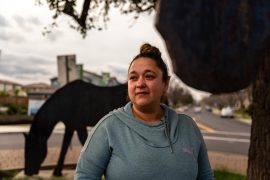Longer Looks: Bad Behavior Treatment; End Of Life Decisions
Every week reporter Ankita Rao selects interesting reading from around the Web.
Los Angeles Times: Bad Behavior Isn't An Illness
When the 1980 edition of the Diagnostic and Statistical Manual of Mental Disorders (commonly known as the DSM-3) was being prepared, psychiatrist Allen Frances lobbied for the inclusion of a new diagnosis: masochistic personality disorder. His push failed, and by the time the fourth edition came out in 1994 (edited by Frances), he was glad it had. He no longer believed such a condition existed. ... Yet the new DSM-5 does agree with abused women that their male abusers are suffering from a psychiatric condition: intermittent explosive disorder. The diagnostic criteria include having had three violent and unpremeditated outbursts in a 12-month period in which people or animals were hurt. Leaving aside the question of why the diagnosis should require three rather than two or four behavioral outbursts in 12 months (or, for that matter, in six or 18 months), a question must be asked: Is the habit of losing one's temper and destroying things or hurting people really a medical condition? Doesn't the diagnosis empty the act both of meaning and moral content, all in the service of a spurious objectivity? (Theodore Dalyrymple, 11/5).
The Atlantic: My Mother Deserved To Die Comfortably
"Can you look at this for me?" Feng, my grandparents' neighbor, handed me a doctor's report written in Chinese along with a box of his mother's new chemotherapy drug. Everyone in my grandparents' little town in China knew me as the hotshot granddaughter getting her Ph.D. in the U.S., but I had to confess that my medical knowledge was limited to English, and I wasn't a professional. I handed the report to my father. "Don't tell your mother that her cancer might recur," he advised. "She needs to have hope that she'll get better." While he isn’t a medical professional either, my father had supported my mother through most of her four-year battle with lung cancer and was familiar with much of the jargon. … I had watched my mother die in pain in a hospital because my father didn't allow us to discuss the possibility of death, and she never filled out an advance directive. I tried to refuse further medical intervention, and my father told me I was killing her. I didn't want Feng's family to go through that (Jenny Qi, 11/6).
Stanford Medicine: Almost Without Hope
In the emergency room of the Rosebud Indian Health Service Hospital, suicide attempts by drug overdose are seen nearly nightly. Alcohol-related car accident injuries fill many of the small hospital's beds, competing for space with tuberculosis, pneumonia and liver and kidney failure. Diabetes is common, leading to loss of life and limb. The physical complications of poverty, joblessness and epidemic rates of alcoholism, diabetes and depression spill over into the wards here at the only hospital on the Rosebud Reservation, which has a population of 13,000 and stretches across 1,970 square miles of South Dakota prairie. Life is short, violence high and health care lacking in Todd County, the second poorest county in the nation (Tracie White, 11/2013).
The Baltimore Sun: Linda's Journey
Linda Hershey lost her nose to squamous cell cancer in 2007. She chose nose reconstruction surgery at Johns Hopkins, the beginning of a years-long journey marked by medical and emotional challenges. This four-part series explores Hershey's long campaign to have her nose rebuilt (Algerina Perna, 11/5).
Center for Investigative Reporting: Rehab Clinics Cut Off For Questionable Billing Still Reaped Federal Funds
Days after a Los Angeles County inspector identified possible forgery in the files of a small drug rehabilitation center, she received a hand-delivered letter expressing the clinic’s “profound gratitude.” Inside was $1,000. The county labeled it a bribe and dropped its contract with Goretti Health Services in 2008, records show. ... But with its Drug Medi-Cal contract canceled, the Lawndale clinic kept itself afloat with a second taxpayer-funded program, receiving $380,000 in federal Access to Recovery grants. The government funds are controlled by two different divisions of the same state department – housed in the same Sacramento building. One division is on the third floor; the other is on the fourth (Christina Jewett and Will Evans, 11/6).






